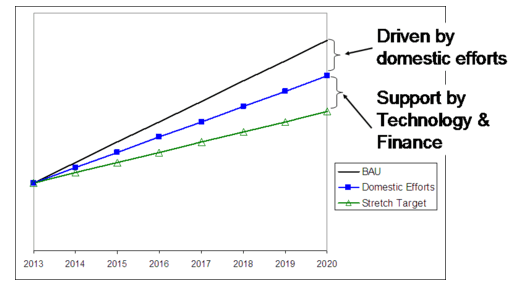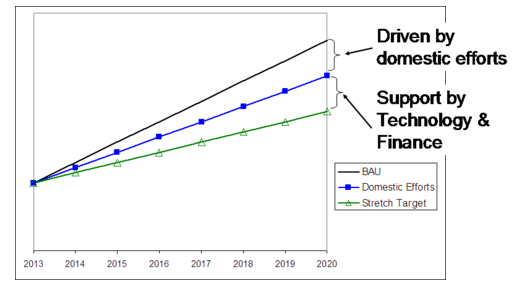People always ask me: how do we get a strong international commitment to solve global warming pollution? What “tools” do U.S. negotiators (and others) have to secure an equitable commitment from all major emitters to reduce global warming pollution? How do we support the most vulnerable developing countries in adapting to the impacts of global warming?
These questions are extremely relevant right now as the international climate negotiations are getting serious, the US is finally back, and Representatives Waxman and Markey just released a “discussion draft” for spurring clean energy and global warming solutions (full draft is available here).
While others in the NRDC team have provided some insights on key elements of the discussion draft and what it means for creating clean energy and clean jobs (see all posts here), I’ll discuss the international provisions. What do these provisions mean for helping to secure a strong international commitment in Copenhagen this December?
This discussion draft provides some very important tools for US negotiators so they can help to secure a strong international global warming commitment. This begins the serious debate in the US that will lay the foundation for getting a strong agreement in Copenhagen that puts the world on the path to creating clean energy and solving global warming.
The discussion draft does this in four ways:
- Driving energy and global warming solutions to reduce US global warming pollution;
- Creating “tools” for US negotiators to secure strong global warming commitments from all countries;
- Providing the right mix of incentives for addressing deforestation emissions; and
- Supporting the most vulnerable developing countries in adapting to the impacts of global warming.
Driving energy and global warming solutions. This discussion draft proposes a set of energy and climate policies which will result in US emissions sources being reduced to:
- 3% below 2005 levels in 2012;
- 20% below 2005 levels in 2020 (7% below 1990 levels);
- 42% below 2005 levels in 2030 (32% below 1990 levels); and
- 83% below 2005 levels in 2050 (80% below 1990 levels).
And, this discussion draft adds to these emissions reductions in two ways:
- Providing “supplemental funding” to incentive deforestation emissions reductions in developing countries-this is estimated to increase the US reduction effort by 10% in 2020; and
- Discounting of offsets.
The combination of these efforts is estimated to produce emissions reductions resulting in US emissions being 30-36% below 2005 levels in 2020 (or 19-26% below 1990 levels).
Creating tools for US negotiators to secure strong global warming commitments. The discussion draft contains essentially four tools for securing a strong global warming commitment from all major players:
- Designing international carbon market access rules to encourage unilateral actions from developing countries before they can sell credits into the US market;
- Providing incentives to achieve emissions reductions in international deforestation emissions;
- Creating incentives for exporting clean energy technologies; and
- Supporting developing countries to adapt to global warming and reduce national security threats.
These are powerful tools that the US negotiators can use to help get a strong international agreement that puts the world effectively on the path to solving global warming.
International carbon offset access rules. International offsets will be issued only to developing countries that are part of a multilateral or bilateral agreement with the US. The program is to identify sectors of specific countries where emissions credits can be generated only on a sectoral basis (as I’ve discussed in evolving from “offsets” to sectoral approaches for developing countries). There are a number of criteria that will be used to determine if a country and sector will be eligible for crediting only on a sectoral basis, including:
- The country has comparatively high emissions or greater levels of economic development;
- That it would be a sector covered by the US cap (e.g., electricity, industrial, transportation, etc.); and
- The sector provides products that are sold in internationally competitive markets.
Credits for these sectors in the country shall be on the basis of an established performance level. And these performance levels shall be established at a level lower than the business-as-usual level. To better visualize this framework, the following graph provides an example.

Sectors not covered by the sectoral regulation would also be available to generate credits, but these sources might not have to be controlled at a sectoral level before they can generate credits. For example, tree replanting (formally known as afforestation and reforestation) might not have to be controlled at a sectoral level, but could instead be done at a project level.
Incentives for reductions in deforestation emissions. The discussion contains two incentive mechanisms to reduce emissions from deforestation, which account for up to 20% of global emissions and are a critical piece of solving global warming:
- market readiness and emissions reductions through a “supplemental” set aside of allowances; and
- carbon credits for national deforestation reductions.
Market readiness and emissions reductions through the “supplemental”. As I discussed above, there is also a separate program to achieve deforestation emissions reductions and to prepare countries for active participation in the deforestation carbon credits. The discussion draft sets aside 5% of the allowance value in 2020 from the emissions trading program for this purpose.
The program is designed to achieve a specific amount of reductions in deforestation emissions which “supplement” the reductions achieved by the US national emissions target (as discussed above). And the program is designed to support efforts to avoid leakage — i.e., shifting deforestation to a country that isn’t currently deforesting at high rates — in countries with largely intact native forests.
There are number of activities which can be supported to achieve this overall emissions reduction objective, including national or subnational activities, enforcement, and efforts to address illegal logging.
Carbon credits for national deforestation reductions. In addition, to the sectoral crediting discussed above, emissions offsets can also be generated from countries that reduce their national deforestation emissions for all relevant carbon stocks. In order to generate emissions reduction credits, the country will have had to reduce their deforestation emissions below a pre-determined “nationally appropriate mitigation commitment or action” that establishes a trajectory that would result in zero gross deforestation not later than 20 years after they enter the program (see my discussion of the Brazil plan to get a sense of this baseline for one country). There are protections for indigenous rights and provisions to ensure that financing flows to the local actors on the ground in the country.
Incentives for clean energy export to developing countries that take on their own commitment. The discussion draft includes the creation of an International Clean Technology Fund to:
- encourage countries to adopt policies and measures that substantially reduce emissions; and
- assist in the widespread deployment of technologies that reduce emissions.
Eligible countries must have undertaken nationally appropriate mitigation activities through an international agreement or by a Presidential determination that they have taken a substantial reduction that is monitored and verified.
Developing country adaptation and reducing national security threats. The draft creates an International Climate Change Adaptation Program to assist the most vulnerable developing countries to adapt to global warming. And this program is aimed at preventing “potentially significant threat multiplier for instability around the world”. My colleague Melanie Nakagawa will provide more detail on the adaptation provisions.
———————-
As we work to get a strong international agreement to address global warming in Copenhagen later this year, it is important that the US climate negotiators have the right tools in hand to secure a strong commitment. We don’t have many tools in our “toolbox” and we need to use each of them effectively.
There has been a lot of attention to this discussion draft and the US clean energy and global warming solutions at the negotiations that I’m participating in right now in Germany. The sprint has begun and the US is moving in the right direction (at long last)!



